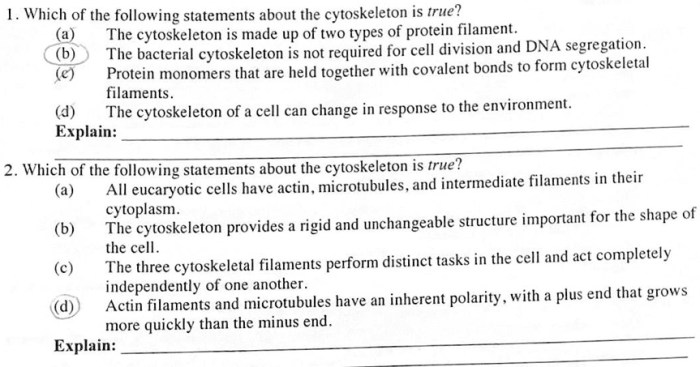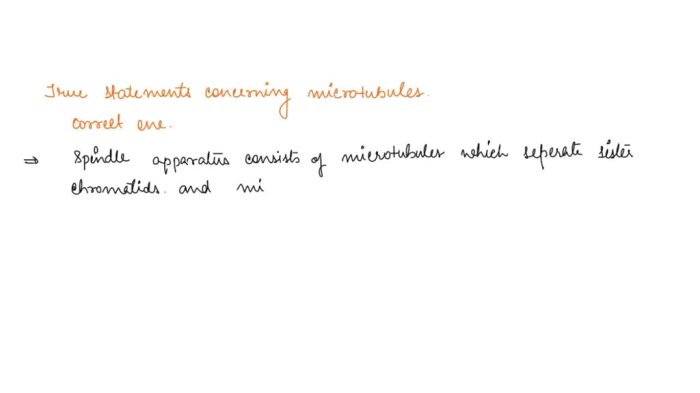Which of the following statements about the cytoskeleton is correct? This question delves into the intricate world of the cytoskeleton, a dynamic network of protein filaments that plays a crucial role in maintaining cell shape, facilitating movement, and organizing cellular processes.
Join us as we explore the structure, functions, dynamics, and disorders associated with this remarkable cellular component.
The cytoskeleton, composed of microtubules, microfilaments, and intermediate filaments, forms a complex and highly organized framework within cells. These filaments interact with motor proteins to generate forces that drive cellular movement, including cell division, migration, and intracellular transport. Moreover, the cytoskeleton serves as a scaffold for organelle positioning and plays a vital role in signal transduction and cellular responses to external cues.
Structure and Composition of the Cytoskeleton

The cytoskeleton is a dynamic and intricate network of protein filaments and tubules that provides structural support and organization to eukaryotic cells. It plays a crucial role in maintaining cell shape, facilitating cellular movement, and regulating intracellular processes.
Types of Cytoskeletal Filaments
- Microtubules:Hollow, cylindrical structures composed of tubulin proteins. They are responsible for cell shape, intracellular transport, and cell division.
- Microfilaments (Actin filaments):Thin, solid filaments made of actin proteins. They are involved in cell movement, cell division, and cell adhesion.
- Intermediate Filaments:Tough, fibrous filaments with diverse compositions depending on cell type. They provide structural support and resistance to mechanical stress.
Functions of the Cytoskeleton

Maintaining Cell Shape and Stability
The cytoskeleton acts as a scaffold that maintains the shape and stability of cells. Microtubules and intermediate filaments form a rigid framework that resists deformation, while microfilaments provide a flexible network that allows for cell shape changes.
Cellular Movement, Which of the following statements about the cytoskeleton is correct
- Cell Division:Microtubules form the mitotic spindle, which separates chromosomes during cell division.
- Cell Migration:Microfilaments and microtubules drive cell movement by interacting with motor proteins.
Intracellular Transport and Organelle Positioning
Microtubules serve as tracks for motor proteins that transport vesicles and organelles throughout the cell. Microfilaments are involved in organelle positioning and cell polarity.
Dynamics and Regulation of the Cytoskeleton

The cytoskeleton is a highly dynamic structure that undergoes constant assembly and disassembly. This dynamic behavior is essential for cell growth, movement, and response to external cues.
Cytoskeletal Assembly and Disassembly
The assembly and disassembly of cytoskeletal filaments are regulated by a complex network of proteins and signaling pathways. Motor proteins, such as kinesins and dyneins, facilitate the transport and assembly of microtubules, while actin-binding proteins regulate microfilament dynamics.
Regulation in Response to External Cues
The cytoskeleton responds to external cues and cellular signals to adapt to changing conditions. For example, growth factors can stimulate the assembly of microfilaments to promote cell migration, while mechanical stress can trigger the formation of stress fibers to reinforce the cytoskeleton.
Cytoskeletal Disorders: Which Of The Following Statements About The Cytoskeleton Is Correct

Common Disorders
- Neurodegenerative Diseases:Mutations in cytoskeletal proteins can lead to neurodegenerative diseases such as Alzheimer’s and Parkinson’s.
- Cardiomyopathies:Defects in cytoskeletal proteins in heart muscle cells can cause cardiomyopathies, leading to heart failure.
- Skin Disorders:Mutations in intermediate filaments can result in skin disorders such as epidermolysis bullosa simplex.
Underlying Causes and Mechanisms
Cytoskeletal disorders can arise from genetic mutations, environmental factors, or a combination of both. Mutations in cytoskeletal genes can disrupt the structure or function of cytoskeletal filaments, leading to cellular dysfunction and disease.
Therapeutic Strategies
Therapeutic strategies for cytoskeletal disorders aim to restore cytoskeletal function and alleviate disease symptoms. These strategies include gene therapy, protein replacement therapy, and pharmacological interventions that target cytoskeletal regulators.
Detailed FAQs
What is the primary function of the cytoskeleton?
The cytoskeleton primarily functions to maintain cell shape and stability, facilitate cellular movement, and organize intracellular transport and organelle positioning.
How is the cytoskeleton regulated?
The cytoskeleton is regulated through a complex interplay of signaling pathways, motor proteins, and regulatory proteins that control filament assembly, disassembly, and dynamics.
What are common cytoskeletal disorders?
Common cytoskeletal disorders include neurodegenerative diseases such as Alzheimer’s and Parkinson’s, muscle disorders such as muscular dystrophy, and certain types of cancer.